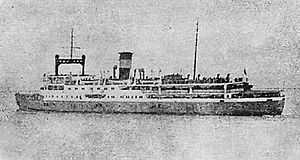SS Kiangya
 | |
| Career | |
|---|---|
| Completed: | 1939 |
| Fate: | Sank 1948 |
| General characteristics | |
| Type: | Steamship |
| Displacement: | 2,100 tons |
SS Kiangya or Jiangya (Chinese: t 江亞輪, s 江亚轮, p Jiāngyà Lún) was a Chinese passenger steamship that blew up near the mouth of the Huangpu River 50 miles (80 km) north of Shanghai on 3 or 4 December 1948. Her wreck was cleared from the channel in 1956 and her hull refurbished, re-entering service. She was renamed the SS Dongfang Hong 8 (t 东方红8, s 东方红8, p Dōngfāng Hóng Bā, lit. "The East is Red #8") during the Cultural Revolution and retired during modernisations in 1983.

The Kiangya was one of eight ships operated by the Shanghai Merchants Group and the sister ship of the SS Kiangking (江静轮, Jiāngjìng Lún). She had a displacement of 2,100 tons. At the time of her explosion during the Chinese Civil War, she was bound for Ningpo from Shanghai's Shiliupu Dock. She was packed with refugees fleeing the advancing Communists. She probably hit a mine, possibly laid by the Imperial Japanese Navy during the Second World War. The exact death toll is unknown. Although her official capacity was 1,186 passengers, the manifest listed 2,150 and she was almost certainly carrying many additional stowaways. Rescuers were unaware of the disaster for some hours. It is thought that between 2,750 and 3,920 died, with 700 to 1,000 survivors being picked up by other vessels.
SS Dongfang Hong 8
The hull of the Kiangya had broken in half but, in 1956, the two pieces were removed in order to dredge that area of the river. The process took 160 days, after which the pieces were removed to the Jiangnan Shipyard and refurbished. She re-entered service at Shanghai's Shiliupu Dock on 4 February 1959, after which she served as a local ferry and for shipping between Shanghai and Wuhan. She was renamed the Dongfang Hong 8 in November 1966 during the Cultural Revolution. She was retired in 1983. During shipbreaking operations in June 2000, a major oil fire broke out.
Legacy
The ship's wooden steering wheel is preserved at the East Zhejiang Maritime Affairs and Folk Custom Museum (t 浙東海事民俗博物館, s 浙东海事民俗博物馆, p Zhèdōng Hǎishì Mínsú Bówùguǎn) in Ningbo, China.
The ship gave her name to Jiangyanansha, one of the component shoals of Jiuduansha off eastern Shanghai.
See also
References
- "Chinese Shipping Disasters: Two Steamers Sunk by Explosions". The Times. 6 December 1948.
External links
- "江亚号客轮" ["Jiangya Passenger Ship"] at Baidu Baike (Chinese)
- ""Jiangya" Shipwreck in 1948- A Tragedy More Serious Than Titanic". China Tibet Information Center. November 2001. Archived from the original on 12 February 2005.
- "Too Many of Us". Time. 13 December 1948. (subscription required (help)).